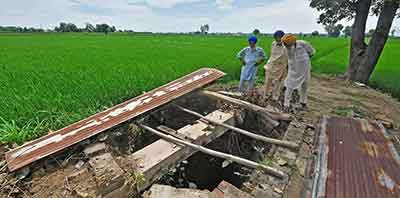Date: 11/03/2023
Relevance: GS-3: Issues related to direct and indirect farm subsidies and minimum support prices; Major crops-cropping patterns in various parts of the country, - different types of irrigation and irrigation system storage.
Key Phrases: Power Subsidy Policy, Government Exchequer, Groundwater, Small Farmers, Semi-Medium Farmers, Agriculture Census, Tube-Wells, Ecological Balance.
Context:
- The provision of free power to farmers in Punjab has been a contentious issue since 1997, as it is believed to place a burden on the state government's finances and exacerbate the depletion of groundwater resources.
Key Highlights:
- The payment for electricity in the 2022-23 fiscal year has
reached an unprecedented ₹7,000 crore, with approximately ₹4,000 crore
allocated to large farmers who own over 10 acres of land.
- As a result, there is now a need to contemplate the regulation of free power distribution
- Numerous studies have indicated that limiting free power access for large farmers could result in a savings of approximately ₹2,500-3,000 crore annually for the state treasury, which could then be utilized for the betterment of small and marginal farmers.
Current Status:
- The Agriculture Census of 2015-16 revealed that Punjab has
approximately 11 lakh operational land-owning farmers who operate around
14.50 lakh tube wells.
- Among them, about 1.6 lakh farmers own less than 2.5 acres of land and are classified as marginal farmers, while 2.1 lakhs own between 2.5 and 5 acres (small farmers), and 3.7 lakhs own between 5 and 10 acres (semi-medium farmers).
- Additionally, approximately 3.1 lakhs farmers own more than 10 and up to 25 acres of land, and 60,000 own landholdings over 25 acres, classified as medium and big farmers.
- Out of the 11 lakhs farmers in Punjab, 3.7 lakhs farmers who hold over 10 acres of land possess multiple motored tube wells and receive more free power than marginal and small farmers.
- According to a report submitted by a group of experts led by Montek
Singh Ahluwalia to the Punjab government in 2020:-
- 56% of the total power subsidy that the state bears annually goes to medium and big farmers who own more than 10 acres.
- The Punjab State Farmers' and Farm Workers' Commission had earlier recommended withdrawing free power to farmers who own over 10 acres or pay income tax.
- Therefore, the mandate of only one motor up to a certain horsepower to be allowed as pricing free for all the farmers, would reduce subsidy and restore ecological balance..
Power Subsidies:
- The total power subsidy bill for the current fiscal year 2022-23 is expected to be around ₹15,846 crore, with agriculture consumers accounting for ₹6,947 crore, domestic categories (including 300 units free) for ₹6,396 crore, and industrial consumers for ₹2,503 crore.
- In 1997-98, when electricity was made free for all farmers by then Chief Minister, the total power subsidy bill was only ₹604 crore. This translates to a massive 2,623.5 per cent increase in power subsidy from 1997-98 to 2022.
- According to data from the Punjab State Power Corporation Ltd (PSPCL),
around 14.5 lakh agriculture tube wells receive free power in the state.
- This number has increased from 2.8 lakh tube wells in the 1980s.
- The rise in tube wells has led to an increase in rice cultivation and a decline in the water table, due to the water-intensive nature of rice cultivation.
- The percentage of acreage under paddy has increased from 6 per cent in 1970-71 to 40 per cent in 2021-22, whereas the percentage of acreage under wheat has only increased from 40.5 per cent in 1970-71 to 44.9 per cent in 2021-22.
- Conversely, the acreage under pulses has decreased from 7.3 to 0.4 per cent, and the acreage under oilseeds has decreased from 5.2 to 0.5 percent during the same period.
- Exploitation of groundwater by the big farmers reduces the amount of groundwater available for marginal and small farmers.
Way Forward:
- It is imperative to implement a strong power subsidy policy.
- Maharashtra has already initiated measures to regulate agriculture tube wells, and the Punjab State Electricity Regulatory Commission (PSERC) should follow suit and establish a suitable farm power subsidy policy.
- To alleviate the subsidy burden on the state, it could replace
the multi-motored tube wells of large farmers with single-motored tube
wells.
- Additionally, a majority of electric tube wells should be replaced with subsidized solar tube wells
Source: The Hindu BL
Mains Question:
Q. What steps can be taken to address the power subsidy policy in agriculture and reduce the subsidy burden on the state? Discuss (150 words).







